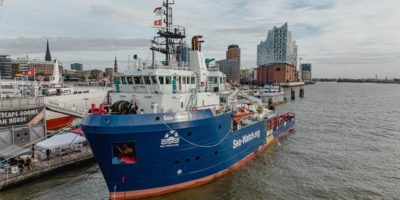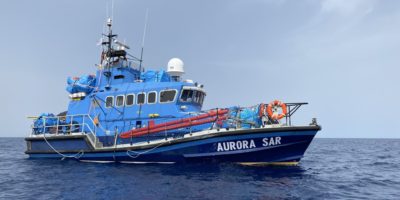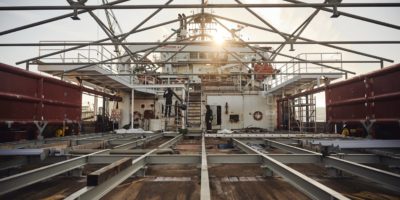Joint Statement by Alarm Phone, Mediterranea Saving Humans and Sea-Watch
On Saturday, 11th March, just two weeks after at least 79 people drowned in a shipwreck off the Italian coast, Italian and Maltese authorities left once again people dying at sea. This time, their politics of non-assistance and the delegation of their duties to the so-called Libyan Coast Guard led to the death of 30 people who were on a boat in distress in international waters, in the contested Libyan Search-and-Rescue (SAR) region. The boat carried 47 people and was adrift at sea. Of these, only 17 people survived due to the intervention of a merchant vessel. The 30 people who died could be still alive, if only the Italian and Maltese authorities had decided to immediately coordinate a proper rescue operation.
These deaths are not the result of an accident. They are the consequence of deliberate political choices. Italian and Maltese authorities could have intervened immediately. Instead, they chose to wait for too long and referred to the so-called Libyan Coast Guard as the responsible and ‘competent’ authority, thereby wasting the time that was needed to save all of the distressed.
The Italian, Maltese, as well as the Libyan authorities were first informed about the distress case on March 11 at 2:28h CET (see timeline below) by the Alarm Phone. The Oil Tanker AMAX AVENUE, and some time later the merchant vessel GAMMA STAR, were in the vicinity of the distressed boat but passed by. Several hours later, another merchant vessel, the BASILIS L, finally directed itself towards the position of the boat in danger. Waiting for a better equipped vessel for a rescue operation, it monitored the boat in distress. The Italian and Maltese authorities decided to wait, in vain, for the so-called Libyan Coast Guard to launch its patrol boats, in order to illegally pull all people back to Libya instead of rescuing them to an European port.
Despite the extremely challenging maritime conditions and the desperate state of the stranded boat, neither the Italian, nor the Maltese or the Libyan authorities activated their resources for a rescue operation – for over 30 hours after the first alert by Alarm Phone. In the past, the Maritime Rescue Coordination Center Rome already conducted coordination of merchant vessels in other cases outside their Search and Rescue area (1). Moreover, the location where the shipwreck occurred was in international waters, outside of Libyan territorial waters. The boat in distress was within the area of operations of the European mission EUNAVFORMED IRINI and the Italian ‘Mare Sicuro’ mission, with both Italian and European military assets continuously present. None of these assets replied to the call for help sent out by Seabird, a monitoring aircraft operated by Sea-Watch, on the radio; nor were they engaged in the rescue operation by the well-informed Italian or Maltese authorities. The Italian authorities delegated the rescue to merchant vessels instead that were not equipped for rescue operations.
Both, the delay in rescue and the delegation of responsibility for rescue to merchant vessels not equipped to rescue, are part of a political strategy that focuses either on delivering people in the hands of Libyan militias or abandoning them at sea. For the deaths of 30 people, as well as of innumerable others at Europe’s maritime borders, Italy, Malta and other EU member states bear primary responsibility.
As Alarm Phone, Mediterranea Saving Humans and Sea-Watch, we denounce and urge European member states, primary Italy and Malta, to end their border externalisation policies and the delegation of duties to Libya. Both have been central factors leading to the death of the 30 people in distress, as well as thousands of others before.
The Italian and Maltese authorities must cease to refer distress cases to the so-called Libyan Coast Guard, which has an appalling human rights record and has forcefully returned over 100.000 people to inhumane conditions in Libya. Moreover, the contested Libyan Search and Rescue region cannot be viewed as under the exclusive responsibility of Libyan authorities. Ultimately, the Italian and Maltese authorities also have to end their reliance on merchant vessels alone to fulfil their duty to rescue.
Many questions remain open and still need to be answered: Why did the Italian and Maltese authorities fail to intervene and rescue the persons in distress? Why has no EUNAVFOR MED asset reacted to the mayday relay by Seabird? All of these authorities need to provide an account of their role in this case and their failure to act.
We urge the European Union to ensure safe and legal pathways to Europe and engage in coordinated Search and Rescue operations, instead of financing and equipping the so-called Libyan Coast Guard, supporting illegal pullbacks under international law.
(1) Examples of such cases of rescues by merchant vessels in Libyan SAR coordinated by MRCC Rome:
https://twitter.com/scandura/status/1586442702068994048?s=20&t=678YEHDH1wW4VABZZ59-eg
https://twitter.com/alarm_phone/status/1588249230438584320
https://twitter.com/alarm_phone/status/1616089062678450177
Timeline of Events
Saturday March 11th
01:32h CET: In the night, Alarm Phone receives the first call from the people in distress. People are screaming “please help me” repeatedly, but cannot share a GPS position.
01:38h CET: Alarm Phone receives a first GPS position (N 33 55, E 018 27), but the line cuts. Alarm Phone tries to confirm the position by repeatedly trying to reach the boat in distress.
02:09h CET: Alarm Phone reaches the boat again. The position (N 33 56, E 018 28) shows that the boat is adrift. The communication with the people in distress is extremely difficult because of strong wind.
02:28h CET: Alarm Phone sends the first email to the Italian Maritime Rescue Coordination Centre (ITMRCC), RCC Malta and the Libyan Joint Rescue Coordination Centre (JRCC Libya) to inform them about the distress situation.
03:10h CET: As the Oil Tanker AMAX AVENUE (IMO: 9419450) is approaching the area of distress, Alarm Phone emails authorities to alert them about the need to rescue, and at 3:28h CET contacts the insurance and ship owner companies of the tanker via email and phone.
09:50h CET: Alarm Phone realises that the Oil Tanker AMAX AVENUE is not changing its course. As merchant vessel GAMMA STAR (IMO: 7703259) is close to the boat in distress, Alarm Phone updates authorities to inform them of this rescue possibility.
09:53h CET: The people in distress report that they left Tobruk 2 days ago. The person on the phone is crying, as are many others on board as can be heard in the background. The people in distress report that they have no food or water left and repeatedly ask for rescue. During the following hours, Alarm Phone is in constant contact with the people on the boat. The people on board are terrified, screaming for help. They report that they are out of fuel and the boat is damaged. All GPS positions confirm the boat is adrift. Alarm Phone continuously informs all authorities about the distress situation both emailing and calling ITMRCC, RCC Malta and JRCC Libya (this includes attempts to reach the so-called Libyan Coast Guard on many available phone numbers).
10:32h CET: Sea-Watch’s monitoring aircraft Seabird sights the boat in distress in the so-called Libyan Search and Rescue (SAR) zone.
10:34h CET: Seabird sends a “Mayday Relay” on the radio (an emergency procedure that provides information about a boat in distress via maritime or aerial radio, requesting any asset in the vicinity to assist).
10:37h CET: The Merchant Vessel BASILIS L (IMO: 9290505), flying the flag of the Marshall Islands, acknowledges the Mayday Relay. The vessel informs to be 15 nautical miles (nautical miles is the unit of measurement used at sea. 1 nautical mile is equal to 1,852 kilometers) away from the distress case and to be heading there.
11:18h CET: Seabird’s ground crew sends an email to the Italian, Maltese and Libyan authorities, with the merchant vessel BASILIS L in CC, to inform them about the boat in distress.
11:27h CET: Seabird’s ground crew calls the ITMRCC. The ITMRCC confirms that they received the email. After stressing the urgency of the case and asking about their intentions, the Italian officer refers to the Libyan authorities and hangs up.
11:30 CET: In a call with the merchant vessel BASILIS L, Alarm Phone learns that the vessel received the order from the Libyan authorities to monitor the situation until the so-called Libyan Coast Guard would arrive and return the people to Libya.
11:31h CET: Seabird calls the merchant vessel BASILIS L on the radio, asking if they need an updated GPS position, as the boat in distress is drifting. They answer that they are in contact with the so-called Libyan Coast Guard, following instructions by ITMRCC. The so-called Libyan Coast Guard gave them a waypoint where they should proceed.
12:10h CET: Seabird’s ground crew calls JRCC Libya: the Libyan authorities are aware of the distress case and say that they had forwarded the information to operations center in Benghazi. Seabird’s ground crew asks if they are facilitating a rescue operation. The Libyan authorities respond that they are not at the moment.
12:11h CET: Seabird’s ground crew sends an email to the merchant vessel BASILIS L, reminding them of the duty to render assistance and sending Sea-Watch’s rescue kit.
12:12h CET: Seabird’s aircrew calls the merchant vessel BASILIS L, reminding them of the state of the boat in distress, and their duty to rescue.
12:15h CET: Alarm Phone tries to contact the merchant vessel BASILIS L.
12:30 CET: The merchant vessel BASILIS L is assessing the situation and monitoring the boat in distress.
12:39h CET: The merchant vessel BASILIS L is at 0.8 nautical mile from the people in distress.
12:50h CET: Seabird’s aircrew calls BASILIS L, telling them that based on the information from the ground crew, the so-called Libyan Coast Guard is not facilitating a rescue currently. The merchant vessel answers they are following instructions given by JRCC, who had said that they would send a boat, the merchant vessel cannot rescue due to bad weather.
13:12h CET: Seabird’s ground crew calls JRCC Libya: JRCC only instructed to provide shelter to boat in distress and no rescue instructions. JRCC Libya wants to send a vessel from Benghazi to rescue, and adds: “If the merchant vessel wants to rescue, they shall go ahead.”
13:25h CET: Seabird’s aircrew forwards this information from JRCC to BASILIS L.
13:26h CET: Seabird leaves the scene.
14:33h CET: Seabird’s ground crew sends a follow-up email to the merchant vessel BASILIS L.
14:50h CET: Seabird’s ground crew sends a follow-up email to the Italian, Maltese and Libyan authorities.
15:29h CET: Seabird’s ground crew tries to reach authorities in Benghazi – no one picks up.
16:35h CET: Alarm Phone, after failing to reach the Libyan authorities on different phone numbers, finally reaches a phone number of the so-called Libyan Coast guard in Tripoli. The Libyan officer says that they had told the merchant vessel to rescue the boat at 13:30h CET and that they did not have any vessels available, neither in Benghazi nor in Tripoli, so they would not do the rescue.
16:51h CET: Seabird’s ground crew calls JRCC Libya: the officer says that there is no vessel available to be sent from Benghazi – there are only available vessels in western Libya.
17:06h CET: Seabird’s ground crew calls the ITMRCC and tells MRCC Rome that JRCC had informed them of their inability to send a rescue asset. Seabird’s ground crew asks who would now be coordinating, as JRCC is not able to respond or coordinate this distress case. The Italian officer hanges up.
18:20h CET: Seabird’s ground crew calls RCC Malta, the officer hangs up.
18:44h CET: Alarm Phone learns from the so-called Libyan Coast Guard that they are in touch with a merchant vessel and ITMRCC is taking over the coordination of the operation.
19:59h CET: The so-called Libyan Coast Guard confirms again to Alarm Phone that ITMRCC takes over the operation because the Libyan authorities are not able to send a vessel.
Sunday March 12th
06:50h CET: After being in contact with the people in distress throughout the night, the people on board call Alarm Phone again to report that they are very exhausted. They say that, for three days already, they are without help at sea. Many of them are crying.
07:20h CET: Alarm Phone receives a call from the boat in distress but no communication is possible. This is the last contact with the people in distress.
14:14h CET: Alarm Phone reaches out in vain to the vessels BASILIS L, ATLANTIC NORTH (IMO: 9236597) and KINLING (IMO: 9893814), which can be seen on Vesselfinder near the last known position of the boat.
14:35h CET: Alarm Phone learns that the merchant vessel FROLAND (IMO: 9505584) took 17 persons on board after the boat in distress capsized in the morning. There is no information available if other merchant vessels rescued other people.
16:23h CET: Merchant vessel MEDKON SAMSUN is also heading to the distressed boat, with Misrata as destination.
Monday March 13th
07:31h CET: ITMRCC sends out an Inmarsat message requesting all ships in the area of distress to have a sharp lookout for the 30 missing people.











